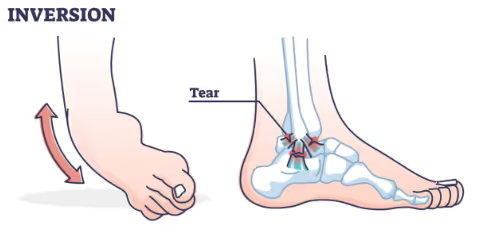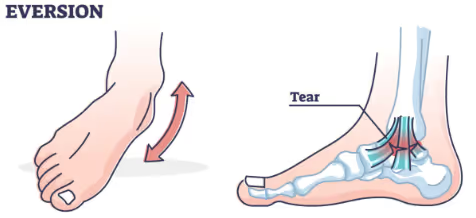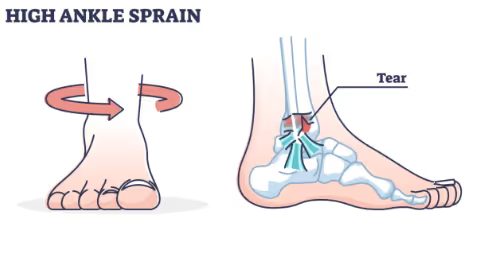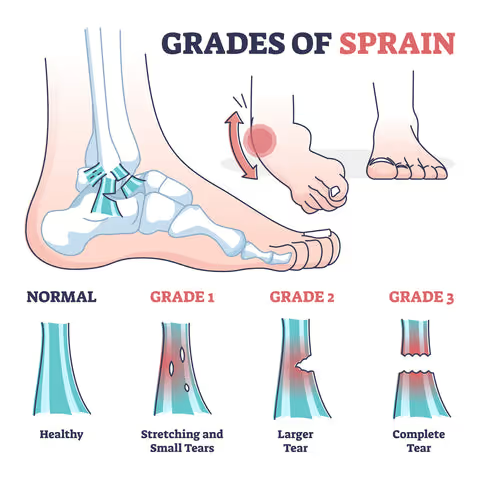As a physical therapist at Conquer Movement working with Wilmington athletes, I encounter ankle sprains frequently. Ankle sprains are a common injury among athletes, particularly in sports involving quick movements, jumping, and changes in direction like basketball, soccer, volleyball, lacrosse, and football. These injuries occur when the ligaments supporting the ankle joint are stretched or torn, often due to sudden twisting or rolling of the foot. The ankle is a crucial component of athletic performance, providing balance, stability, and propulsion, making ankle sprains particularly frustrating for athletes as they can significantly impact performance and lead to extended time off the field or court.To effectively manage and prevent ankle sprains, it's important to understand the different types of ankle sprains and their severity.
Types of Ankle Sprains
Inversion Ankle Sprain
- An inversion ankle sprain occurs when the foot rolls inward, stretching or tearing ligaments on the outer side of the ankle.
- This is the most common type of ankle sprain. It happens when the ankle rolls inward, often when stepping off a curb or uneven ground. The outside of the ankle feels pain and may swell.

Eversion Ankle Sprain
- An eversion ankle sprain happens when the foot rolls outward, affecting the ligaments on the inner side of the ankle.
- Less common, this injury occurs when the ankle rolls outward, often when someone steps into a hole or is struck on the outside of the foot. Pain is often felt on the inside of the ankle.

Syndesmotic or High Ankle Sprain
- A syndesmotic sprain, often referred to as a high ankle sprain, involves damage to the ligaments connecting the tibia and fibula, the two bones in your lower leg.
- This is a more severe injury that often happens when the ankle is twisted forcefully, such as in sports like football or basketball. It often causes pain on the outside of the ankle and may limit the ability to put weight on the foot.

Severity of Sprains
Grade 1: Mild Sprain
- A Grade 1 sprain involves a mild stretching or micro tearing of the ankle ligament, resulting in minimal joint instability. Symptoms typically include mild pain, tenderness, and slight swelling.
- To visualize this, imagine your ankle ligament as a rubber band. A Grade 1 sprain is like stretching that rubber band a little too far. It might sting a bit and you might have a little swelling, but it's not too bad. You can probably still walk on it, though it might be a bit sore. Think of it as a minor inconvenience.
Grade 2: Moderate Sprain
- Progressing in severity, a Grade 2 sprain involves a partial rupture of the ankle ligament, leading to moderate joint instability and pain. Swelling, bruising, and difficulty bearing weight are common symptoms.
- While still manageable, the injury is more significant. To continue the analogy, it's as if the rubber band has been stretched beyond its limit and has begun to tear. This results in more pain and swelling, making it challenging to put full weight on the ankle.
Grade 3: Severe Sprain
- A Grade 3 sprain represents the most severe level of injury, resulting in a complete rupture of the ankle ligament. This causes severe pain, swelling, and significant joint instability.
- To illustrate, imagine the rubber band has snapped completely. The ankle becomes extremely unstable, experiencing significant pain and swelling, making it difficult to put any weight on it.
Common Misconceptions About Ankle Sprains
There are several misconceptions surrounding ankle sprains that can hinder recovery and increase the risk of re-injury. Let's address some of the most common ones:
- Myth 1: All ankle sprains are the same: This is untrue. As listed above, there are different severities and types of ankle sprains, requiring different treatment approaches.
- Myth 2: Rest is the only treatment: While rest may have benefits, it's not enough. Early mobilization and physical therapy are crucial for a full recovery.
- Myth 3: Once the pain is gone, the injury is healed: Pain relief does not always equate to complete healing. Chronic ankle instability and ankle sprains can lead to injuries elsewhere. Continued rehabilitation is essential for athletes at all levels
By understanding the true nature of ankle sprains and seeking appropriate care, athletes can effectively manage these injuries and return to their sport.
Your Path to Recovery and stages of healing process
Physical Therapy plays a crucial role in the recovery process for ankle sprains. By addressing pain, swelling, and restoring range of motion, physical therapists help individuals return to their desired activities as quickly and safely as possible. Through targeted exercises and modalities, physical therapists can improve strength, balance, and proprioception, reducing the risk of re-injury.
A well-structured rehabilitation program typically involves three healing stages:
- Healing Stage: Focuses on reducing pain, swelling, and restoring range of motion. While tissue healing occurs.
- Loading Stage: Emphasizes strengthening the ankle muscles, improving balance, and proprioception.
- Return to Sport Stage: Introduces plyometric exercises and sport-specific drills to prepare the athlete for a return to the high level demands of their sport.
The duration of each phase will vary depending on the severity and type of the sprain the athlete has.
Don't let an ankle sprain sideline you! At Conquer Movement, our performance-based physical therapy approach can help you recover quickly, reduce the risk of re-injury, and get back to doing what you love. Time is of the essence when it comes to ankle sprains. Early intervention can significantly impact your recovery time.
Book your FREE discovery call with us today to schedule an appointment and start your journey back to full strength.

